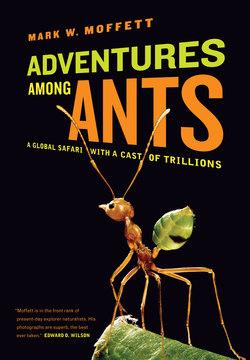Читать книгу Adventures among Ants - Mark W. Moffett - Страница 16
На сайте Литреса книга снята с продажи.
Оглавление6 big game hunters
It was January 2005, and I was in Africa again. I had already had many adventures in the sub-Saharan region. Years before, pursuing my love of frogs, I had hunted the goliath frog in Cameroon, hoping to set a new world’s record with a 3.3-kilogram specimen but settling for one that weighed a little less and was a meter long with its legs extended. In Gabon, I’d surveyed ants in the rainforest canopy, working on a canopy raft—a network of pontoons placed 40 meters high on the tree crowns. (My fellow researchers and I were so bothered by the dominant Crematogaster, or “acrobat” ants, that we nicknamed them “Crematobastards.”) In Ivory Coast and Senegal, I’d collected praying mantises, and in South Africa and Namibia I’d searched for spiders, flies, termites, and other curiosities. But this trip to Nigeria would be my first opportunity to investigate the similarities between the army ant and the marauder ant, my Pheidologeton diversus.
On the previous trips I’d stumbled upon Africa’s infamous Dorylus army ants and especially noted the swarm-raiding species commonly known as driver ants for their habit—shared with swarm-raiding army ants in the New World and the marauder ant in Asia—of herding their prey before them.1 I came to regret the stumbling. The Dorylus I encountered bit me fiercely when, distracted by the sight of a vervet monkey in the trees, I stepped on a packed file of the dark, shining workers. Their violent response reminded me of Ogden Nash’s character study in his poem “The Ant”:2
The ant has made himself illustrious
Through constant industry industrious.
So what?
Would you be calm and placid
If you were full of formic acid?
The pain of a driver ant bite has more to do with mechanical damage than poison, though. Each chomp forced me to stop and extract a worker from my skin or crush with a thumbnail those gnawing at my clothes. (Their heads stayed embedded in the fabric through several washings.) Bites on a fingertip were so agonizing that pulling the ant off wasn’t an option: when I gripped the offender between two fingers of the opposite hand, she would clamp down even more savagely on the delicate finger pad. In time I found a solution: I inserted the finger in my mouth and crushed the ant’s head between my teeth, which immediately disengaged her jaws. The ant was about the size of a Tic Tac breath mint and just as crisp.
Munching on the insect, I detected a hint of nuttiness and a trace of the pungent sourness of formic acid. Driver ants are not as oily as the plump marauder food-storage repletes. Nor are they as tangy as weaver ants, which have a mentholated lime flavor and are served in India as a condiment with curry dishes. Certainly they aren’t as desirable as honeypot ants, which Australian aborigines and southwestern American Indians find delectable.
Though they do not offer the candied delights of honeypots, driver ants are toothsome enough to chimpanzees to be one of their dietary mainstays, and that’s what had brought me to Nigeria. Caspar Schöning, who at that time was studying driver ants at Copenhagen University, had invited me to join him while he organized a research project on ant consumption with University College of London primatologist Volker Sommer. Joining us would be Darren Ellis, a student of Volker’s.
